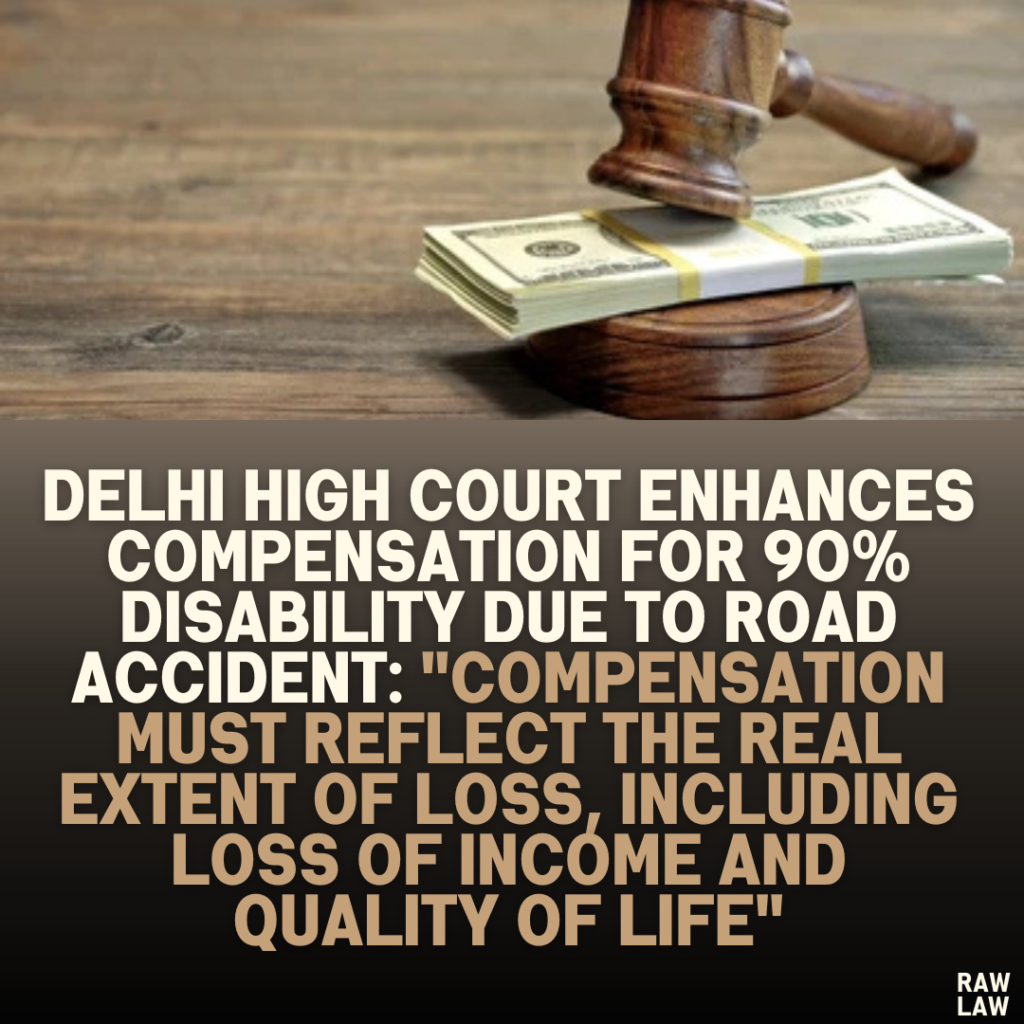Court’s Decision
The High Court increased the compensation from ₹16,86,358 to ₹29,61,000, payable with interest at 9% per annum. The court held that the initial award did not sufficiently account for the appellant’s loss of income, future earnings, and the severity of his injuries. The enhanced compensation aims to address both economic and non-economic damages.
Facts
- Accident Details: On May 8, 2016, the appellant, a carpenter, was riding a motorcycle with his mother as a pillion rider. The motorcycle was hit by a rashly driven vehicle. The accident led to the death of the mother and grievous injuries to the appellant.
- Injuries: The appellant suffered permanent disability (90% in the right lower limb), requiring amputation. He underwent multiple surgeries and extended hospitalization from May 2016 to July 2017.
- Profession: The appellant was self-employed as a carpenter, earning ₹3,03,096 annually, as substantiated by his Income Tax Returns (ITRs).
Issues
- Adequacy of Compensation: Whether the Motor Accidents Claims Tribunal (MACT) had awarded sufficient compensation to account for the injuries and losses suffered.
- Loss of Income: Whether the appellant was entitled to compensation for income lost during the treatment period.
- Future Loss of Earnings: Whether the appellant’s disability had been adequately factored into the calculation of future earnings.
- Non-Pecuniary Damages: Whether the compensation for mental shock, disfiguration, and loss of amenities of life was fair.
- Prosthetic Expenses: Whether the award considered costs for the maintenance and replacement of prosthetic limbs.
Petitioner’s Arguments
- The appellant sought enhancement, arguing that the initial award failed to:
- Compensate for income lost during the 14-month treatment period.
- Address the impact of his 90% disability on future earning capacity.
- Adequately cover mental and physical shock, disfiguration, and loss of amenities of life.
- Include sufficient provision for repair and maintenance of prosthetic limbs.
Respondent’s Arguments
- The insurance company contended:
- The award was reasonable and already covered the appellant’s losses.
- The appellant’s business had continued to function during his treatment, mitigating loss of income.
- There was no documentary proof of the appellant’s business being closed or income being significantly impacted.
Analysis of the Law
The court applied principles under the Motor Vehicles Act, 1988, focusing on fair compensation for accident victims. Key considerations included:
- Loss of Income During Treatment:
- The appellant was hospitalized for over a year and continued rehabilitation thereafter.
- The court assessed income lost during the 14-month treatment period based on ITR records, awarding ₹3,53,612 for this head.
- Future Loss of Earnings:
- Despite being a business owner, the appellant’s active involvement in operations was crucial.
- The court calculated future loss of earnings considering a 40% functional disability, using a multiplier of 7 based on the appellant’s age, awarding ₹8,50,000.
- Prosthetic Costs:
- Prosthetic replacement costs of ₹4,60,950 were multiplied by three (reflecting the need for replacements over the appellant’s lifetime), totaling ₹13,82,850.
- The court held that additional compensation for maintenance was unnecessary, as replacements were already covered.
- Non-Pecuniary Damages:
- The court awarded ₹50,000 for loss of amenities and ₹30,000 for disfiguration, recognizing the appellant’s reduced quality of life.
Precedent Analysis
The court referenced judicial precedents emphasizing:
- The necessity of awarding fair compensation to cover both tangible and intangible losses.
- The need to consider the victim’s occupation, age, and extent of disability when calculating future earnings.
Court’s Reasoning
- The court emphasized the appellant’s extensive injuries and their impact on his professional and personal life.
- It recognized that the appellant’s active participation in his business was vital and would be significantly hampered due to his disability.
- On prosthetic costs, the court reasoned that replacements were sufficient to cover lifetime needs, negating the need for additional maintenance compensation.
Key observation: “Compensation must reflect the real extent of loss and suffering of the victim, ensuring just recompense.”
Conclusion
The court enhanced the compensation to ₹29,61,000, broken down as follows:
| Head of Compensation | Tribunal Award | High Court Award |
|---|---|---|
| Medical Treatment | ₹13,508 | ₹13,508 |
| Pain and Suffering | ₹2,00,000 | ₹2,00,000 |
| Loss of Income During Treatment | NIL | ₹3,53,612 |
| Future Loss of Earnings | NIL | ₹8,50,000 |
| Conveyance, Attendant, Diet Charges | ₹90,000 | ₹90,000 |
| Cost of Prosthesis | ₹13,82,850 | ₹13,82,850 |
| Loss of Amenities of Life | NIL | ₹50,000 |
| Disfiguration | NIL | ₹30,000 |
| Total | ₹16,86,358 | ₹29,61,000 |
Implications
- This judgment reinforces the importance of holistic compensation for accident victims, considering both pecuniary and non-pecuniary losses.
- It sets a precedent for adequately addressing the lifelong impact of severe disabilities in personal injury cases.




Pingback: Delhi High Court Slams Customs Department for Delay in Finalizing Assessment, Directs Immediate Release of Bank Guarantee with 6% Interest and Allows Appeal Against ₹1 Crore Duty Demand - Raw Law